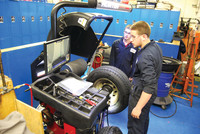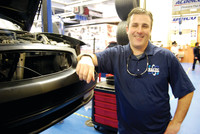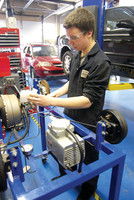Don’t be surprised if your car mechanic doesn’t look under the hood…at least not right away.
David Tibbetts should know. He’s the instructor of the auto mechanics program at the Warwick …
This item is available in full to subscribers.
We have recently launched a new and improved website. To continue reading, you will need to either log into your subscriber account, or purchase a new subscription.
If you are a current print subscriber, you can set up a free website account by clicking here.
Otherwise, click here to view your options for subscribing.
Please log in to continue |
|



Don’t be surprised if your car mechanic doesn’t look under the hood…at least not right away.
David Tibbetts should know. He’s the instructor of the auto mechanics program at the Warwick Area Career and Technical Center and on the frontline of training the next generation of auto mechanics.
Tibbetts remembers the day when mechanics spent a half hour troubleshooting a problem and then another three to four hours under the hood fixing it. He says those days are gone and the amount of time under the hood is a half hour while three hours is easily spent looking at a screen and diagnosing a problem.
Ironically, it seems - being in front of a screen, that is - is the way everything is going. Tibbetts recalls the days when students spent their time in a garage, and probably under a car, as soon as they got out of school. Today kids spend their free time on their cell phones and iPads.
So, is there a new generation of motorheads, students who really are into cars, and will become the next auto mechanics or will machines take over to fix the machines?
There’s hope there will be people who not only know how to keep cars on the road but love to do it. Furthermore, as Tibbetts knows, the students straight out of the program can make good money. Students from the career and technical center automotive program are in demand with some stepping into jobs that are paying $50,000 within a year of graduation.
“If they hustle they can make good money out of the gate,” Tibbetts says of program graduates.
Nate Costa, a junior, is one of those new generations of motorheads.
“I’ve always enjoyed cars. It just comes easily,” he said Thursday looking under the hood of a Durango with the same enthusiasm an artist would look at an original Van Gogh. Costa studied the screen of a hand held diagnostic unit that was plugged into the engine compartment. He could have been on his cellphone. He was in another world.
Fixing today’s automobiles is knowing that sometimes the simplest of things can be the cause of a “check engine” trouble signal says instructor Jason Marley. He points out that an engine oil dipstick that hasn’t been fully reseated can trigger a sensor, causing the check engine light to go on. That’s one extreme. On the other is understanding the complexity, and quite often the danger, of today’s cars. He notes that working on hybrid and electrical cars require specialized training and certifications.
“If you touch the wrong wire, you’re dead,” he said.
The Warwick program that has 45 students is the state’s only career and technical center with a third level certification from the National Automotive Technicians Education Foundation. The first quarter of the program is an introduction to tools and safety procedures including operation of the automotive lifts. In the second quarter students are working with suspensions and steering and by the third quarter they’re on to engines and brakes.
“It’s basic maintenance,” says Tibbetts.
It gets much more complicated from there. One of the sophisticated pieces of equipment students Justin Ware and Nick Berardis were working with Thursday is an $18,000 wheel-balancing machine. Tibbetts said tire pressure monitoring systems demand intensive training.
He said much more time is spent on problem solving than during the days when students got their hands greasy and dirt under their fingernails. He said the job not only requires “critical thinking” but also patience.
“Kids want an instant answer,” he said. Getting every detail right is essential.
“You do a pinpoint test and you miss one thing and you’re talking of hours going down the road,” he said.
Tibbetts said demand for program graduates remains high. A setback has been a lack of new cars for students to work on. There was a time when dealers donated newer vehicles to the program. That’s ceased. The program relies heavily on people looking to have students work on their cars.
But whether students stay in the field or not, Tibbetts points out they are learning skills such as welding, hydraulics systems and electronics that can be valuable to a number of career paths.
And like today’s cars that are perpetually changing, he sees the program as developing a foundation of learning.
“Fifty percent of the jobs [for the new generation] haven’t been invented yet. They’re going to need transferable skills.”
1 comment on this item Please log in to comment by clicking here
RISchadenfreude
It's always good to see trades and skills promoted- too often, students are sent off to college without the aptitude to earn a degree.
I love working on cars, learning at my father's side and then on my own, everything from changing plugs to changing pistons and intake manifolds, carburetors, etc. No sensors or emission controls, either- just horsepower, and sometimes enough room to sit on the fender with my feet in the engine bay.
Tuesday, April 25, 2017 Report this